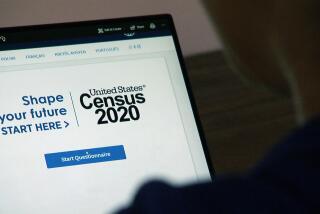Skerry on Adjusted Census Numbers
- Share via
Claiming to put politics aside, Peter Skerry (Opinion, Jan. 7) argues that the president-elect should not support the Census Bureau’s release in March of corrected figures that will eliminate the undercount of African Americans, other minorities and children. Skerry states that “the formulas determining who gets funded are shaped by the political clout that comes from voting, not from being counted in the census.” Shaped, yes; determined, no. Programs like Head Start, farm subsidies, school and urban housing construction funding and Medicaid are allocated by statute, and population figures are the main factor used in crafting those statutes’ formulas. Politicians need the most accurate data available in order to make informed decisions on critical funding issues. Small changes to population at the local level can have an enormous impact on funding levels.
Skerry also says correction relies on fallible human enumerators, who in 1990 made errors. These fallible enumerators do the original head-counts too, and that is why a correction is necessary. The second sample survey was done by the most experienced enumerators using the best equipment available. Is it perfect? Probably not, but its quality is vastly superior to the original enumeration. By comparing the two counts using statistical methods, a more accurate picture of our society is attained.
Skerry says refining a massive count “can actually make things worse, especially when the differences that matter are relatively small--like minority undercounts or the recent election results.” The undercount in 1990 was 8.4 million people, mostly minorities, and it could well be that high again this year. If Skerry thinks that is a small number, his dictionary needs updating.
REP. CAROLYN B. MALONEY
D-N.Y., Ranking Minority Member
Subcommittee on the Census
More to Read
Get the L.A. Times Politics newsletter
Deeply reported insights into legislation, politics and policy from Sacramento, Washington and beyond. In your inbox twice per week.
You may occasionally receive promotional content from the Los Angeles Times.










